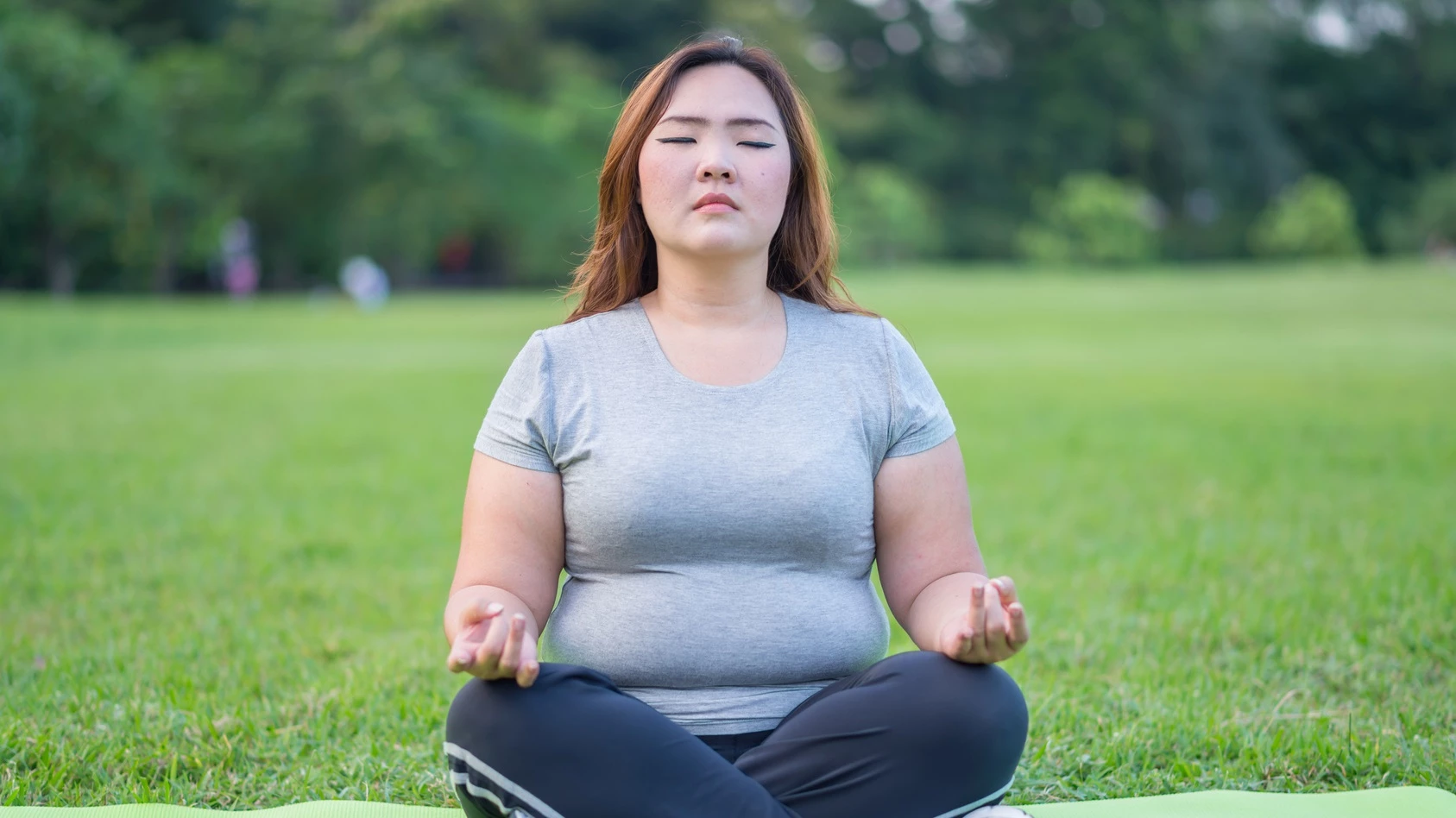Big Benefits: How Yoga Benefits Big Bodies On and Off the Mat

When I first started practicing yoga, I was by far the largest student in any of my yoga classes. The very first yoga class I ever attended was in the early ’90s. It was held in a huge gym at my university, with several hundred students and a teacher I never even got to talk to. It was incredibly intimidating, but it was also a lot of fun!
Yoga- Providing Fun and Meaning
I remember being surprised how much I liked the practice, even though I didn’t know what I was doing, and couldn’t follow every move. I was surprised that even though this class was packed with all-the-beautiful-people, I didn’t feel like I didn’t belong. This was even more striking because I felt like I didn’t belong most of the time in college, so being able to take a break from the incessant mind-chatter about my non-belonging-ness was an incredible godsend.
Yoga was this magical thing that I somehow was able to keep doing despite myself. Most other activities I took up ended as quickly as they began, usually with tears of shame and self-recrimination. What I know now is that those “failed” activities were lacking two major components that I need to be motivated: fun and meaning. Yoga provided these two things in spades, and has provided so much more than I ever could have anticipated.
Little did I know that yoga would eventually become the most important practice of my life. At the time, it just seemed fun and relaxing, so I kept going. Eventually, after many years and a long, windy road, I became a yoga teacher and a psychotherapist specializing in yoga and meditation for larger bodies.
The practice of yoga has incredible depth, and what I have discovered over the years is that the benefits of yoga just keep expanding with me. As I grow in my practice, yoga grows with me. Yoga builds on itself. You might start going to yoga for any number of reasons, but as you become more regular in your practice, it becomes clear that yoga has a lot more to offer than you bargained for.
Health Benefits of Yoga
According to the NIH, more than 13 million adults practiced yoga in the last year. Studies show that people initially start a yoga practice for a variety of reasons ranging from specific medical conditions to general maintenance of health and wellness.[i] Twenty-two percent start practicing yoga simply because their doctor recommends it!
Once people start practicing yoga, especially on a regular basis, the benefits stack up. In one six-month study on back pain, people reported significantly less disability, pain, and depression than those who sought standard care.[ii] [iii] [iv]
A 2010 study showed that women who had a regular yoga practice recovered from stress more quickly than women without a regular practice.[v] A 2013 study showed that regular yoga practice altered brain structure and connectivity, potentially improving pain tolerance and emotional regulation.[vi] Yoga is amazing. For everybody. And for a lot of reasons.
Benefits of Yoga for Larger Bodies
I believe that yoga is particularly amazing for those of us in larger bodies. Our culture is steeped in stigma and stereotypes about large bodies that can be deeply damaging to the psyche and the spirit. As a therapist, I work with trauma all of the time stemming from the bullying, shaming and policing of people’s bodies throughout their lives. Yoga offers a break from the trauma, and the chance to reconnect to the Self.
Yoga is about tuning in, rather than tuning out. In terms of the physical, yoga teaches us to become aware of our bodies, and to love and appreciate our bodies as they are, in this moment. The power of being present to the body and the Self should not be underestimated. It is the practice of being present that makes yoga so beneficial in so many ways.
Being present means that we are conscious. When we are conscious, we have the capacity to listen to our bodies, and respond appropriately and intuitively to what they need. While we might begin practicing being present and conscious on the yoga mat, eventually we start to be conscious off the mat as well. It becomes normal to eat intuitively, move intuitively and rest intuitively. Rather than listening to an external authority, we become the authority on ourselves.
For a lot of us, this is a huge turning point. Rather than trying to fit ourselves into to an outside “expert’s” plan, the guidance for what our bodies need comes from inside! This is critical for healing and becoming more empowered in how we care for ourselves. When we are listening to our bodies, they tell us what we need to know to be healthy, which is validated in study after study on intuitive eating, Health at Every Size, and exercise motivation.
When we learn to listen to our bodies through a yogic practice, our bodies become stronger, more flexible, and more capable, of course, but the benefit extends beyond the physical. Our minds become more nimble, responsive, calm and clear. Our lives become happier. The shape and size of our bodies may or may not change, but the quality of our lives in the bodies we have right now improves exponentially.
It has been many years since my first yoga class, and I find that I am no longer the only person of size in many of my classes. Yahoo! Of course, some of this has to do with choosing places that support me and have a depth of practice that goes beyond just the physical.
There are yoga studios out there that are not welcoming, so I encourage people to find places that are working toward being body-positive. If you are lucky, you may even find places in your neck of the woods where classes are specifically suited to students with larger bodies. If you don’t have these in your area, there are many online resources with lists of body-positive yoga teachers, yoga membership sites, Facebook groups and trainings for teachers. Ask for what you need, and you might be surprised. Yoga is waiting for you.
 Rachel Dhanya Smith a body positive psychotherapist, meditation teacher, and yoga teacher specializing in helping women transform their relationships with food, their bodies, and themselves. She offers individual counseling, body image coaching, and private yoga classes in person and online. She also offers group meditation, yoga, and body image classes and workshops in Colorado and across the U.S. You can learn more about her work at www.bigheartcounseling.com
Rachel Dhanya Smith a body positive psychotherapist, meditation teacher, and yoga teacher specializing in helping women transform their relationships with food, their bodies, and themselves. She offers individual counseling, body image coaching, and private yoga classes in person and online. She also offers group meditation, yoga, and body image classes and workshops in Colorado and across the U.S. You can learn more about her work at www.bigheartcounseling.com
Resources:
[ii]Sherman KJ, Cherkin DC, Wellman RD, et al. A randomized trial comparing yoga, stretching, and a self-care book for chronic low back pain. Archives of Internal Medicine. 2011;171(22):2019–2026.
[iii]Tilbrook HE, Cox H, Hewitt CE, et al. Yoga for chronic low back pain: a randomized trial. Annals of Internal Medicine. 2011;155(9):569–578.
[iv]Uebelacker LA, Epstein-Lubow G, Gaudiano BA, et al. Hatha yoga for depression: a critical review of the evidence for efficacy, plausible mechanisms of action, and directions for future research. Journal of Psychiatric Practice. 2010; 16(1):22–33.
[v]Kiecolt-Glaser JK, Christian L, Preston H, et al. Stress, inflammation, and yoga practice. Psychosomatic Medicine. 2010; 72(2):113–121.
[vi]Villemure C, Čeko M, Cotton VA, Bushnell C. Insular cortex mediates increased pain tolerance in yoga practitioners. Cerebral Cortex. May 21, 2013. Epub ahead of print.



